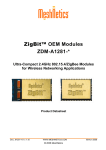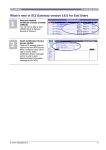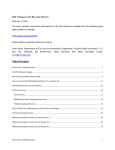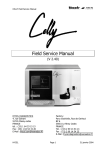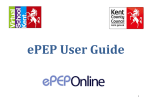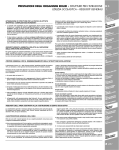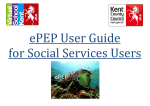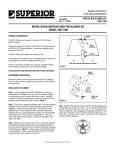Download Assessment Form
Transcript
Specialised Services Commissioning Innovation Fund SSCIF User Guide: Completing the Step 1: SelfAssessment Form The NHS England INFORMATION READER BOX Directorate Medical Nursing Finance Operations Policy Human Resources Publications Gateway Reference: Patients and Information Commissioning Development 00328 Document Purpose Guidance Document Name SSCIF Step 1 User Guide Author NHS England Publication Date 08 August 2013 Target Audience CCG Clinical Leaders, CCG Chief Officers, CSO Managing Directors, Care Trust CEs, Foundation Trust CEs , Medical Directors, Directors of PH, Directors of Nursing, NHS England Regional Directors, NHS England Area Directors, NHS Trust Board Chairs, Special HA CEs, Directors of HR, Directors of Finance, Allied Health Professionals, GPs, Communications Leads, Emergency Care Leads, Directors of Children's Services, NHS Trust CEs, industry non nhs providers Additional Circulation List #VALUE! Description Things to consider when preparing to answer the SSCIF Step 1: SelfAssessment Form Cross Reference Superseded Docs (if applicable) Action Required Timing / Deadlines (if applicable) Contact Details for further information n/a n/a Reference material for making a submision to the SSCIF For immediate publication Bernie Stocks Specialised Services Team Fosse House Leicester LE19 1SX 0 0 Document Status This is a controlled document. Whilst this document may be printed, the electronic version posted on the intranet is the controlled copy. Any printed copies of this document are not controlled. As a controlled document, this document should not be saved onto local or network drives but should always be accessed from the intranet Specialised Services Commissioning Innovation Fund SSCIF User Guide: Completing the Step 1 SelfAssessment Form First published: August 2013 Prepared by Medical Directorate, NHS England Contents Contents .................................................................................................................... 4 About this document ............................................................................................... 5 Background to the creation of the SSCIF Programme.......................................... 6 About the SSCIF Programme .................................................................................. 6 The scope of the SSCIF ........................................................................................... 9 Funding Available .................................................................................................. 10 Who can apply to the SSCIF Programme?........................................................... 10 What to be aware of in planning a submission to the SSCIF ............................. 11 What are the SSCIF Programme submission and assessment processes? ..... 15 What are the SSCIF entry criteria? ....................................................................... 16 Contact us ............................................................................................................... 17 Appendix 1: List of NHS England specialised services Clinical Reference Groups (CRG) by Programme of Care .................................................................. 18 Appendix 2: Using the SSCIF to CIMIT CoLab® Web Platform .......................... 22 Appendix 3: Guide to completing the Step 1: Self-assessment form ................ 28 Appendix 4: About the patient’s care pathway .................................................... 35 Appendix 5: SSCIF timeline ................................................................................... 38 4 About this document 1. This document is a guide for those interested in making a Step 1 submission to the 2013/14 NHS England Specialised Services Commissioning Innovation Fund (SSCIF). 2. If you require general background information about the SSCIF, you can find that in the following documents which are published on the NHS England website. They include: • • 3. About the SSCIF SSCIF Frequently Asked Questions Please see the SSCIF webpage www.england.nhs.uk/resources/spec-commresources/sscif for more information. 5 Background to the creation of the SSCIF Programme 4. Following the publication of the Government’s Plan for Growth report in March 2011, the Department of Health (DH) carried out a consultation exercise on how to drive up quality in the NHS through innovation. Its response, ‘Innovation Health and Wealth (IHW), accelerating adoption and diffusion in the NHS’ was published in December 2011. This included a recommendation for NHS England (then called the NHS Commissioning Board) to create a Specialised Services Commissioning Innovation Fund, (SSCIF) Programme. 5. Further information about the SSCIF Programme can be found at www.england.nhs.uk/resources/spec-comm-resources/sscif/ where you find ‘About the SSCIF’ and a set of frequently asked questions. About the SSCIF Programme 6. The purpose of the SSCIF Programme is to support evaluation projects linked to innovations which are already in the adoption phase of the innovation pipeline, not those in the earlier (invention) or later (diffusion) phases. There are other funds and support mechanisms to support innovators and invention at these points. 7. Shown below in Figure 1: are the four steps in the adoption section of the ‘End to End Innovation Pipeline’ that the SSCIF Programme will fund. These are: effectiveness evaluation, effectiveness testing, innovation implementation and early implementation. 6 8. The SSCIF Programme will fund projects to generate new information, evidence and data on the impact of innovations, including improvements in quality and outcomes for patients and service users, and/or efficiency or reduced NHS activity levels 9. SSCIF evaluation projects will be rapid, typically between six to 18 months in duration. 10. The services that will be covered are the 143 prescribed specialised services directly commissioned by NHS England. These services are commissioned on a national basis by NHS England, using single, national service specifications to set out exactly what is required from service providers in terms of standards and quality of patient care. The commissioning of these services is clinicallyled, through a system of Programmes of Care and Clinical Reference Groups (CRGs). The contracting of services is led at a local level by 10 of the 27 NHS 7 England area teams. For further information about the prescribed services, please go to www.england.nhs.uk/resources/spec-comm-resources/npc-crg/ 11. The outcomes of the evaluation projects will be used by NHS England commissioners to make more informed commissioning decisions, resulting in new commissioning policies or service specifications. 12. There is likely to be more interest in the fund than resources available, therefore any submissions which include funds from partners, and/or other organisations, will enable the SSCIF Programme monies to be allocated across more projects. No preference will be given to submissions with matched funding. 13. The decision of the assessors is final. 14. No undue pressure or influence is to be exerted on assessors or the SSCIF Programme Administration Team. 15. The person who completes the Step 1: Self-Assessment Form will be known as the Lead Applicant and will be the main point of contact throughout the submission process. 16. There is a requirement to identify a practising clinician who will be known as the Lead Healthcare Practitioner (LHP) who will sponsor the submission, lead the delivery of the project, including service delivery, as well as the evaluation of the impact of the innovation. 17. The practising LHP’s organisation will be responsible for the delivery of the SSCIF evaluation project and for ensuring oversight of service delivery and financial management of the project on an operational basis. This organisation will be known as the Applicant Organisation. 18. It is expected that patients, service users and carers will be engaged in the development, delivery and evaluation of submissions to the SSCIF, and in SSCIF evaluation projects, to ensure that there is an understanding of the innovation’s impact on the patient’s experience and to enable feedback on ensuring an optimum care experience. 19. Where information resulting from a research study or similar activity is submitted in support of an application to the SSCIF, the study must have been approved and conducted in accordance with formally established research governance arrangements. This would also apply to information used in the 8 adoption phase, should the application be successful. Confirmation of research ethics approvals must accompany the application. Data that could identify a patient either directly or indirectly must not be submitted. Equality and Diversity 20. Due regard to eliminate discrimination, harassment and victimisation, to advance equality of opportunity, and to foster good relations between people who share a relevant protected characteristic (as cited in under the Equality Act 2010) and those who do not share it, has been given throughout the development of the policies and processes cited in this document. 21. Applicants are asked to give due regard and robust consideration to equality in the development and implementation of their innovation submissions and in their projects, if awarded funding, ensuring that people with protected characteristics or those that find it hard to access services which are provided in a traditional way, are not discriminated against. 22. The SSCIF Programme supports the delivery of the NHS Outcomes Framework 2013/14 in those circumstances where a SSCIF evaluation project, which secures investment, sits within one of the five domains which focus on improving health and reducing health inequalities: Domain 1: Preventing people from dying prematurely Domain 2: Enhancing quality of life for people with long-term conditions Domain 3: Helping people to recover from episodes of ill health or following injury Domain 4: Ensuring that people have a positive experience of care Domain 5: Treating and caring for people in a safe environment and protecting them from avoidable harm The scope of the SSCIF 23. The scope of innovations that will be considered by the SSCIF Programme is broad including innovative service models, pathways, workforce and team approaches, technologies, products, medicines, interventions, devices and diagnostics with the potential to deliver high impact changes in prescribed specialised services directly commissioned by NHS England. 24. The SSCIF Programme is for: 9 • innovations that fall within the direct specialised commissioning responsibilities of NHS England or are applied in a novel way to these prescribed services; and • innovations that have shown promise of delivering an improvement in the quality or cost of service delivery. Funding Available 25. There is up to £50 million available as a non-recurrent fund for SSCIF evaluation projects in 2013/14. This cost is to cover the evaluation and administration costs for the fund and all project costs to be incurred in 2014/15 and 2015/16 for the projects approved in this first round of the SSCIF Programme. 26. Baseline service costs relating to the pathway of care or treatment programme to which the innovation is being applied will not be met by the SSCIF, as these are covered by existing NHS England contracts. Similarly, overheads for NHS Trusts or NHS Foundation Trusts cannot be included in the evaluation costs as these are already funded via existing NHS funding arrangements. The SSCIF will therefore only fund genuinely additional treatment costs associated with the innovation, and evaluation costs. 27. Partners to submissions may be able to part-fund submissions. 28. A range of submissions for small or larger amounts of funding are welcomed, with the smaller amounts starting from £5,000 and the higher end up to a maximum of 25% of the fund value. 29. Where partnership submissions are received, and the partners are non-NHS organisations with access to significant in-house funding and resources, it is envisaged that submissions will not include costs to pay for such support and the appropriateness of the support requested will be considered as part of the Step 3: table top assessment process Who can apply to the SSCIF Programme? 30. At Step 1 and Step 2 in the three-step submission process, anyone can apply to the SSCIF Programme, including the voluntary sector; NHS Trust/NHS Foundation Trust or non-NHS provider staff, commissioners, managers and multi-professional clinicians of all levels; industry, and independent sector providers. 10 31. Submissions can be developed in partnership with one or more of the above organisations. What to be aware of in planning a submission to the SSCIF 32. Successful SSCIF submissions at Steps 2 and 3 of the SSCIF are likely to demonstrate a clear understanding of the following areas and include plans to put these in place if the submission is successful in being awarded funding: Table 1: What to be aware of in planning a submission to the SSCIF 1 2 Lead clinician identified in a NHS Trust/NHS Foundation Trust or nonNHS provider Executive Director Sponsorship A practising Lead Healthcare Practitioner (LHP) to act as clinical lead. The LHP will be responsible for clinical sponsorship of the submission; oversight of the delivery of the service involving the use of the innovation, and the parallel evaluation of the impact of the innovation. Identified Executive Director leads in each partner organisation. This will be somebody who will drive the delivery of the projects, negotiating any potential hurdles should they arise. They will approve the proposed submission to ensure compliance with organisational costing and approvals processes before the submission is made. In an NHS organisation this will ideally be the: Chief Executive, or Medical Director, or Director of Nursing, or Director of Finance/Accounting Officer. In a non-NHS organisation, this role will be that of the Managing Director. Approval will be needed from the Executive Director lead in the case of a conditional offer being made by the Step 4 Fund Decision Panel. The Executive Director lead will be responsible for approving the Service Level Agreement that will be included 11 in the SSCIF Standard Operating Procedure, thereby adhering to the terms and conditions of the SSCIF Programme. Support from business managers, plus the finance and information team in the LHP’s organisation will be required to ensure the accuracy of the finances and service activity information to be included in the submission at Steps 2 and 3, and that the accuracy of these is agreed and authorised internally before the submission is made. Clear governance processes supporting the running of the project, underpinned by timely and accurate data on activity and outcomes so that there is a clear picture of progress which can be reviewed by the Executive Sponsor and the project team. A clear picture of the patient’s journey currently, particularly the flow from GP referral to care and back home, and how it will be improved or different as a result of using the innovation. 3 Support from operational level experts in the provider trust(s) 4 Governance 5 An understanding of the patient/service user’s journey Clarity about how many patients can realistically be included in the service to be provided as part of the project during the timeframe it covers, across the single or multiple provider units covered by the project. 6 The potential benefits of the innovation 7 The right skills and experience in the project team Data 8 Clarity about how many patients will benefit during the project for the population to be covered and how many would benefit nationally if the use of the innovation was rolled out across all appropriate providers. A clear understanding of the promise and benefits of the innovation over what is currently in use in the NHS, underpinned by supporting data and evidence. Recruitment plan for an experienced project team which will have all of the necessary skills to agree actions, including service delivery; evaluating the impact of the innovation on the service and the patient/service user; ensuring appropriate data collection and production of monitoring reports. Clarity of the key data and data sets to be captured to measure the impact of the innovation, and clarity as to whether this is already automatically collected or will need to be manually captured by the project team. As the SSCIF Programme is primarily aimed at providing information for commissioners, submissions will need to specify 12 the key commissioning performance indicators (KPIs) that the innovations will impact upon to inform the commissioning decision. 9 Finance and activity 10 Intellectual Property 11 Public and Patient Engagement 12 Freedom of Information Key Performance Indicators (KPIs) can include at least one of the metrics in Table 2 below and preferably a bundle of these. The costs of the project will be required at Step 2 and Step 3, with as detailed an outline of the costs at Step 2 and an excel spreadsheet to be completed at Step 3, on which the service activity is to be included. Clarity as to whether any background intellectual property rights for the innovation are already in place, and if not, a clear plan for ensuring this is secured for the relevant parties. All of the rights, title and interest in or to any information, data, reports, documents, procedures, forecasts, technology, KnowHow and any other Intellectual Property Rights whatsoever owned by either NHS England or the LHP before the commencement date of the project shall remain the property of that party. Patient and public engagement should be a key part of the design, delivery and evaluation of the impact of the innovation on outcomes and the patient/service user’s experience of the care journey. This should be evidenced. The Freedom of Information Act gives the right to the general public/interested parties to ask public authorities for information they hold in relation to a specific issue. NHS England will comply fully with the obligations placed upon it by the Freedom of Information Act (FOIA) and to ensure that the service it provides for those wishing to gain access to information is simple, efficient, and effective. Any queries relating to the Specialised Services Commissioning Innovation Fund will be managed by the NHS England FOIA team at Tel: 0300 3 11 22 33, Email: [email protected] . Address: NHS England, PO Box 16738, Redditch, B97 9PT. Lead Applicants of submissions will need to make themselves familiar with the Freedom of Information Act, accessed via the Information Commissioner’s website www.ico.gov.uk to view the basis for any exemptions they feel apply to any requests for information from the public under the FOIA. 13 13 Equality and Diversity Equality and diversity are at the heart of the NHS strategy. Due regard to eliminate discrimination, harassment and victimisation, to advance equality of opportunity, and to foster good relations between people who share a relevant protected characteristic (as cited in under the Equality Act 2010) and those who do not share it, has been given throughout the development of the policies and processes cited in this document. Applicants to the SSCIF Programme will be asked to have due regard and give robust consideration to equality in the development and implementation of their innovation submissions and in their projects if awarded funding, ensuring that people with protected characteristics or those that find it hard to access services which are provided in a traditional way, are not discriminated against. Those administering the SSCIF will also need to have due regard to equality in the assessment and prioritisation processes. In addition, assessments will include both the potential cost effectiveness of innovations and their potential impact on reducing health inequalities in access to and outcomes from health services. Table 2: SSCIF project metrics Key Performance Indicator: Description Quality of care Appropriate to the service area Outcomes of care Appropriate to the service area Activity Length of stay, admissions, readmission rates, accident and emergency admission rates, emergency admission rates, Cost Impact on running costs such as in number of cases, revenue or capital costs. Patient Reported Outcome Family and Friends test Measures PROMS, qualitative comments and surveys, specialty specific evaluation measures. 14 What are the SSCIF Programme submission and assessment processes? 33. There are four steps in the submission process. • • • • Step 1: Self-assessment form Step 2: Qualifying submission form Step 3: Detailed submission form Face to face meeting with the Step 4: Fund Decision Panel 34. This document addresses Step 1 of the process only: Table 3: Guide to Step 1 submission and assessment process Step 1 – The Step 1: Self-Assessment Form is a one-page online checklist Making a to be completed by the Lead Applicant to confirm that their submission innovation fits within the specialised services commissioning portfolio; that there is enough information to answer the questions in the next steps of the submission process; and that the innovation relates to a specialised service and meets the SSCIF Programme entry criteria. Step 1 Submission and assessment process In order to access the online self-assessment form, go to www.england.nhs.uk/resources/spec-comm-resources/sscif where you will find a second link to the CIMIT CoLab® web platform where you can register to be a user on the system. The Step 1 form can be located once you have completed registration. If the Lead Applicant is able to answer yes to all of the questions in Step 1, the online system will indicate that their submission has been successful and will indicate this to the SSCIF Programme Administration Team who will send the Lead Applicant an email with information about the next step including the submission forms to complete. If the Lead Applicant is not able to answer yes to all of the questions on the on-line Step 1: Self-assessment form, the submission will automatically be rejected by the online system. If this happens, the innovator may wish to contact their organisation’s lead Director with responsibility for innovation who may be able to advise on those issues that need to be addressed 15 in order to complete a successful submission. Alternatively, it may be that completing the self-assessment form will demonstrate to the Lead Applicant that the innovation is not suitable for consideration or investment by the SSCIF Programme and other sources of support should be explored. Figure 2: SSCIF Programme Submission Process for Lead Applicants What are the SSCIF entry criteria? 35. The SSCIF Programme entry criteria are as follows: • The target service or patient group should be within the list of those prescribed as falling within the direct specialised commissioning responsibilities of NHS England. It is recognised that some innovations may go on to have wider use across the NHS. • Innovations should offer the promise of either addressing an unmet clinical need, or substantial benefits over and above existing treatments in terms of patient outcomes and/or service efficiency. • If the innovation is a product, it should have the relevant marketing authorisation or approval by a competent authority such as the 'CE mark’ which is the manufacturer's declaration that the product meets the 16 requirements of the applicable European Commission directives for medical devices and the Medicines and Healthcare Products Regulatory Agency. • The quality and cost impacts in patient care that the innovation affects and the specific process steps impacted upon must be clearly defined. • There is sufficient evidence of the benefits of the innovation to justify investment in an evaluation project to gather additional data through managed use in a healthcare provider setting. • There is insufficient evidence at the time of submission to enable a substantive commissioning decision or to allow evaluation by bodies such as the National Institute for Health and Care Effectiveness (NICE) or through other highly specialised processes to support a commissioning decision independent of the SSCIF. The SSCIF should not be seen as providing a 'second chance' where commissioning decisions have already been determined. • The prospect of funding from the SSCIF will significantly increase the likelihood of generating sufficient information for commissioners to make a decision about whether the innovation should be used in the NHS, which would be unlikely with the current lack of evidence. • There is sufficient likelihood that the innovation could be diffused through the NHS, at a cost proportional to its benefit, if the results from the evaluation project were successful. • Providers have determined a robust mechanism to ensure that any additional costs associated with the innovation can be charged to other commissioners / funders, where the responsibility for an individual patient does not sit with NHS England. Contact us Contact details for the SSCIF Programme Administration Team are as follows: [email protected]. 17 Appendix 1: List of NHS England specialised services Clinical Reference Groups (CRG) by Programme of Care CRG ID CRG Name CRG Code Programme of Care: Internal Medicine A1 Cystic Fibrosis CFS A2 Hepatobiliary and Pancreas HPB A3 Specialised Endocrinology EDO A4 Vascular Disease VAS A5 Severe and Complex Obesity MOS A6 Renal Dialysis RDI A7 Renal Transplant RTR A8 Specialised Colorectal Services SCS A9 Complex Invasive Cardiology CIC A10 Cardiac Surgery CSY A11 Pulmonary Hypertension PHN A12 Specialised Dermatology DMT A13 Specialised Rheumatology RHU A14 Specialised Respiratory RSP A15 Interventional Radiology IRY A16 Specialised Imaging SIG A17 Specialised Diabetes SDM A18 Heart & Lung Transplantation HLT Programme of Care: Cancer and Blood B1 Radiotherapy RTY B2 PET-CT PET B3 Specialised Cancer SCR B4 Blood & Marrow Transplantation BMT 18 B5 Haemophilia and other bleeding disorders HPA B6 HIV HIV B7 Infectious Diseases INF B8 Haemoglobinopathies HAS B9 Specialised Immunology and Allergy Services IMM B10 Thoracic Surgery TSY B11 Upper GI Surgery UGI B12 Sarcoma SCA B13 CNS Tumours CNS B14 Specialised Urology URO B15 Chemotherapy CTY B16 Complex Head & Neck HAN B17 Teenage and Young Cancer TYA Programme of Care: Mental Health C1 Specialised Services for Eating Disorders EDS C2 High and Medium Secure Mental Health HSM C3 Low Secure Mental Health LSM C4 Specialised Mental Health Services for the Deaf MSD C5 Gender Identity Services GIS C6 Perinatal Mental Health PMH C7 Tier 4 Child & Adolescent Mental Health Services CAM C8 Tier 4 Severe Personality Disorder Services (adults) SPD C9 Mental Health Specialised MHS C10 Forensic Pathway Group FSG C11 CAMHS Secure* CSM Programme of Care: Trauma D1 Complex Disability Equipment CDE 19 D2 Brain Injury & Complex Rehabilitation BIR D3 Adult Neurosurgery NSY D4 Neurosciences NSC D5 Stereotactic Radiosurgery SRS D6 Burn Care BCS D7 Cleft Lip & Palate CLP D8 Specialised Pain SPS D9 Specialised Ear Surgery SES D10 Specialised Orthopaedic Services SOS D11 Hyperbaric Oxygen Therapy HBO D12 Specialised Ophthalmology Services OPS D13 Spinal Cord Injury SCI D14 Complex Spinal Surgery CSS D15 Major Trauma MTS D16 Adult Critical Care ACC Programme of Care: Women and Children E1 Medical Genetics MGS E2 Paediatric Surgery PSS E3 Paediatric Medicine PMS E4 Paediatric Cancer Services PCS E5 Congenital Heart Services (Paediatric Cardiac Services) PCA E6 Metabolic disorders IMD E7 Paediatric Intensive Care PIC E8 Neonatal Critical Care NIC E9 Paediatric Neurosciences PNS E10 Complex Gynaecological Services CGS E11 Specialised Maternity Services SMS 20 E12 Fetal Medicine FMS E13 Multi-System Disorder MSD 21 Appendix 2: Using the SSCIF to CIMIT CoLab® Web Platform Please follow the instructions below to: • • • • Create an account Make your Step 1: Self-Assessment submission Save your submission Submit your submission Login Page- If you already registered in the system, you may do so here; if you need to register, click on the “create an account” link where you can provide your name and email to gain access. Main Page- After logging in, you will be brought to the SSCIF main page below 22 You may begin your submission by clicking the blue button to start the process, where you will be taken to the following page: (more questions in-between not shown here) 23 After all the fields are complete, you may click “save” which will create an online workspace for you to begin working on the step 2 submission form (shown below). There is also the ability to add team members to the proposal (red circle) by entering their email in the “invite user” section after you click on that tab. 24 You can also exit out of the browser and log back in to return to work at a later time. You will be able to go back to your proposal by going to the “my page” tab, and “my initiatives” (below). 25 (Note: make sure you click “proposals” to see your initiatives) From here, you may click on the blue title of each proposal to be taken to the workspace. You may either choose to begin working on your proposal right away, or log out and then log back in to your proposal to complete the online wiki. (Please note, when you log back in you should click on the “documents” tab (circled) to view the wiki). Here you may go into each section by clicking the “edit” button (green circle) to answer each question, where you then click “save” when you are done. It is important to save each section in order to assure that no work will be lost. You may exit out of the window and log back in as many times as you like to complete the submission. 26 After the final field is complete, the following message will show up: For ease of use, you may select “yes mark this as finished”. This will not submit the proposal yet, you will still have time to change your answers. After this is complete, you will see the following message at the top of the page (red circle): From here, you can still go in and edit each question, and log out as many times as you like. When the wiki is complete, you may click the blue Step 2 Form Ready to Review button (green circle) which will then officially submit the proposal for step 2 review. The process will be repeated for step 3 and so forth. 27 Appendix 3: Guide to completing the Step 1: Self-assessment form On this side are the questions from the Step 1 Self-assessment form 1 Lead Applicant Name* Prefix* First Name* Organisation* Email address* Confirm Email address* My phone number (including area code if a landline)* Questions with a star* need to be answered to enable the submission to be automatically accepted 2 Title of proposed SSCIF evaluation project The title of this specialised services innovation project proposal is*: (Max 250 characters). 3 Proposal: The Innovation, the Evidence and Delivery 3.1 The Innovation I have identified the health service problem or need or the efficiency improvement that this innovation addresses *Yes/No On this side is the explanation behind the question and what to consider when answering it Guide to response Jones Mrs Jane Anywhere University Hospitals NHS Trust Your own Your own Your own Guide to response Please give a short title that will make it clear to all readers what the innovation is about. For example ‘The Study of using the X Care Pathway approach in Paediatric Medicine for children with Y condition’ Guide to response Can you describe the clinical/patient outcomes gap that this innovation fills or by how much it is significantly more cost effective than what is used? 28 3.2 3.3 3.4 3.5 Which of the following specialised services Clinical Reference Groups (CRGs) does the innovation best fit? (see list of 74 NHS England specialised services CRGs) Will this innovation impact on the pathway for adults/children/both (tick one) The innovation is distinctly different from the range of approaches used throughout the country and offers improved patient outcomes and quality or service efficiency.* Yes/No Guide: Is it radically different to other current approaches or solutions? If so, could you describe how later on in the process? I have identified the steps in the patient care pathway that this innovation will impact upon and whether the impacts are to improve patient outcomes, increase or reduce cost or reduce NHS activity levels (e.g. reduce acute bed days from eight to five). * Yes/No Guide: I can clearly set out the possible changes the innovation may result in to those process steps i.e. remove three steps from a current 10 step process as a result of this innovation being used or applied. 3.6 In my view, there is insufficient evidence at this time to enable specialised services commissioners to commission the innovation or to take this innovation through national evaluation processes which require a complete evidence base. It therefore warrants a See the list at Appendix 1. The innovation must fit into at least one of these service areas. It may cross a number but choose the single best fit. If the innovation is common to adult and paediatric pathways tick both, if not, tick whichever applies This is asking for confirmation that you believe the innovation is significantly better than what is already being used, have some evidence to support this and will be able to set out the differences in later steps. At Step 2 you will be asked to set out the care pathway or relevant section of this which relates to the innovation and describe what is different between what happens now and how this will be different when the innovation is being used in the SSCIF evaluation project. Please see Appendix 4. Guide to response National evaluation processes require full evidence to be provided for evaluation of the impact of an innovation and many innovations in specialised services may not have this level of data due to the 29 3.7 SSCIF evaluation project to generate data and information to bridge the evidence gap for the innovation and answer key commissioning questions which are unanswered at this time.* Yes/No small number of patients across the country with some conditions. Guide: This may be your view or you may have previously approached specialised services commissioners and they were concerned about the lack of data and other evidence and were unable to commission the innovation as a result. If there is a full evidence base, the innovation will not be suitable for the SSCIF, choose no. I can confirm that to the best of my knowledge, the collection of data to support the commissioning of this innovation is not better suited to being collected in a more formal research and development setting.* Yes/No This is asking for confirmation that the work needed is not a research project. Guide: A SSCIF evaluation project would generate data to inform a commissioning decision. More formal research and development evaluations may have already been completed for marketing authorisation, but formal testing in an NHS service setting may be required to generate additional, peripheral information that cannot be generated in a clinical trial setting. If this is the case pick yes. The SSCIF aims is to provide funding to generate the additional information needed by NHS England for commissioning decisions and whilst there will not be a full evidence base for the innovation, there will be some evidence from case note audit, randomised controlled trials etc. Research is about testing whether something works and developing a final concept, whereas the SSCIF is about taking something that is already proven and testing out whether it works in a different setting, for a different clinical indication, across a larger patient population or in a clinical setting for the first time. You are advised to discuss this with an appropriately qualified person such as your organisation's research 30 The SSCIF Programme is designed to assess the value of an innovation to the NHS and not to answer early stage research questions. Innovations are therefore to have reached a level of evidence to enable use within the NHS outside of a research setting. 3.8 3.9 Evidence I have undertaken a thorough literature review and structured search of the current information about the performance of the innovation and can provide that on request.* Yes/No Guide: This can either be unpublished data such as local registry data, patient record data or as published in journals. We advise that you do not submit a proposal until you have gathered the information you will need to answer this question. We accept that the evidence base may be limited as there must be an evidence gap that needs to be filled to qualify for the SSCIF Programme, but all supporting data will be required by assessors. I confirm that appropriate approval is in place for this innovation if the innovation is a medicinal product or device such CE marking for a medical device or marketing authorisation for a drug. Yes/No/Does not apply (Please note that this question does not apply to pathways and workforce approaches) department, local Academic Health Science Network (AHSN), NHS Innovation Hub or relevant specialised services area team. Guide to response You will be asked to provide a summary data and information resulting from a thorough review of the current published literature setting out the clinical case for the need that the innovation addresses. The data will need to be clinically and statistically significant and be from published or un published sources that will need to be appropriately referenced, such as using the Cochrane system. This will need to be included at Steps 2 and 3 in the SSCIF submission process. If the innovation is a product or a device, it will only be suitable for the SSCIF Programme if it is already on the market and have the relevant marketing authorisation or approval by a competent authority such as the ‘CE mark’ which is the manufacturer’s declaration that the product meets the requirements of the applicable European Commission directives for medical devices. You will need to provide evidence of this at Step 2. 31 3.10 Delivery I understand that I will need to identify a practising Lead Healthcare Practitioner (LHP) to act as sponsor the SSCIF evaluation project and lead the project involving the use of the innovation for its duration and the parallel evaluation of the impact of the innovation.* Yes/No The team can include support and input from staff from partner organisations. The SSCIF is to fund projects in a healthcare setting using an innovation or innovative approach. This process will require appropriate clinical leadership from a clinician (what we refer to as the LHP role) who is currently practising and has the relevant authorisation to do so, including nurses, allied health practitioners such as occupational therapists, clinical scientists, pharmacists, medical staff etc. The LHP role is similar to the Principal Investigator role in research activities. 3.11 I understand that the practising Lead Healthcare Practitioner and I will be required to assemble an appropriate project team with the skills and experience to undertake the project in a healthcare service setting and evaluate its impact. * Yes/No The team can include support and input from staff from partner organisations. Where more than one provider organisation is collaborating on a project, for example three NHS Trusts, then there will be a single, overall LHP who will co-ordinate the project delivery, data collection and clinical standards with individual clinical leads at each provider site. The project team will need to include a diverse range of skills, competencies and experience covering the clinical elements and project management activities., although it is expected/recommended that additional support is secured from provider teams such as innovation, research, evaluation, information, finance, governance, service management, supplies, (equipment testing if appropriate). 32 3.12 I will be able to set out the proposed governance and monitoring arrangements for the project.* Yes/No This may include contributions from a number of partners. 3.13 If there are partners to this submission, they have agreed to participate in the project and support its delivery. Yes/No/Does not apply. This may include contributions from a number of partners. 4. Agreement to terms and conditions 4.1 I accept that the decisions of the various assessors and Fund Decision Panel are final.* Yes/No 4.2 Information about technologies referred to in this submission may be shared with the National Institute for Health and Care Excellence (NICE).* Yes/No/Does not apply Robust project set up will be expected and Lead Applicants will need to set out their plans for this in Step 2 and 3. This would need to include identification of the senior responsible owner such as an executive director to steer the delivery of the project and hold the team to account for delivery, a project manager and regular reporting and steering group meetings. If there is a manufacturer or supplier of a service or a number of provider trusts collaborating on the project submission, they are fully signed up to being involved in using the innovation in their unit for the duration of the project, carrying out data collection and putting in place all of the elements of the project in a rigorous manner. Evidence of this and the support of their Chief Executives, Medical or Nursing Directors and Directors of Finance will be required in Step 2. Guide to response In making a submission to the SSCIF Programme you accept the views of the various assessors which will be called upon to give opinion on the submissions which may result in your innovation being funded or not funded. This question will not affect the decision to proceed to step 2 of the process. At both Steps 1 and 2 of the SSCIF submission process, where the innovation is a 33 Please note that if you give your permission and your innovation is a device, medicinal product or technology, we will forward basic information (product name, intended use) about the technology to relevant programmes at the National Institute for Health and Care Excellence (NICE). For submissions for pharmaceutical innovations, it is expected that the NICE Technology Appraisals Programme will already be aware of the innovation via the NICE Topic Selection function but we are happy to share this submission with them if you wish For the NICE Medical Technologies Evaluation Programme, the purposes of sharing this information is to enable informal, confidential and without-obligation engagement between NICE and the manufacturer, depending on the suitability of the product for evaluation. medical technology, Lead Applicants will be invited to give permission for the SSCIF Programme to share details of the submission with the NICE Medical Technologies Evaluation Programme, to enable informal, confidential and without-obligation engagement between NICE and the manufacturer, dependent on the specific innovation. Where a Step 2 Qualifying Submission is made to the SSCIF, and there is judged to already be a full evidence base for an innovation, the SSCIF Programme Team will recommend to innovators to put forward their innovation to NICE for consideration. If an innovation has already been through guidance and been recommended by NICE, the product may be appropriate for use in other clinical populations or for other indications and it may be that the fund can assess its impact in that new area. 34 Appendix 4: About the patient’s care pathway 1. A care pathway shows in picture form the patient/service user’s journey between the beginning and end of their journey - or particular parts of this such as : 1) home to General Practitioner (GP); 2) GP to the hospital or other care setting; 3) within different parts of the hospital system (such as (i) outpatient to (ii) list for surgery to (iii) theatre to (iv) recovery to (v) intensive care to (vi) general ward and, 4) hospital to home/care home/other will have a number of separate steps of assessment and interaction with health staff and is known as the patient/service user care pathway. 2. Assessors will want to understand at what point in the patient/service user’s journey the innovation is used and where it impacts, and the difference this will make in the number of steps in the care pathway as compared to the current situation. 3. For the Step 2: Qualifying Submission Form, you will need to set out the care pathway as it is currently and how this will be different using the innovation. 4. Below in Pictures 1 and 2 is an example of a renal transplant pathway as it is currently - this would be the current pathway and is shown in two formats – one for the overall journey and a second showing how the pathway breaks down into four key elements of assessment, maintenance, transplant and follow up. 5. If there was an innovation in this pathway, there would be a second diagram showing the place at which the innovation is used and a description of the difference it would make in terms of quality or efficiency such as shown in the text box below. Innovation used at this point. Impact is to reduce bed days from 8 to 5. 35 Picture 1: Renal Transplant Care Pathway Reproduced with permission from Keith Rigg Chair, Renal Transplant Clinical Reference Group and Consultant Surgeon 36 Picture 2: Renal Transplant Care Pathway - spilt by key sections of the pathway Reproduced with permission from Keith Rigg, Chair, Renal Transplant Clinical Reference Group and Consultant Surgeon 37 Appendix 5: SSCIF timeline 1. Pre-launch notification will take place on 2 August 2013. 2. The SSCIF Programme will be open to submissions in the week commencing 2 September 2013. To enable applicants to prepare for submission of the Step 1: Self-assessment form, the website was launched on 2 August 2013. Please note that completed forms cannot be submitted until 2 September 2013. 3. Step 1: Self-assessment forms can be completed as soon as the fund is launched and this will generate a request for a Step 2: Qualifying submission form to be made available to the Lead Applicant and team he/she invites into the secure, web-based work space. 4. The deadline for Step 2: Qualifying submission forms is midnight on 4 October. 5. CRG Chairs will be sent links to score the Step 2 submissions for their area as they are submitted, with the final batch of scores needing to be submitted by midnight on 25 October. 6. Scores will be collated in order of the highest score first and shared with the Directors of the Programme of Care Boards to discuss between 29 and 31 October to agree minimum score level for Lead Applicants to be invited to submit Step 3 submissions. 7. Successful Lead Applicants will receive links to the Step 3 submission forms on 1 November for completion and uploading by midnight on 28 November, including making an offer of development support from an Academic Health Science Network (AHSN). 8. From 4 December, the SSCIF Programme Administration Team will batch and send completed Step 3 submissions to AHSNs for review/peer review for return by midnight on 3 January. 9. On 6 January 2014 the SSCIF Programme Administration Team will identify the list of innovations across the four outcomes: (1) Rejected; (2) Fast track innovations list to inform future commissioning decisions; ( 3) A shortlist of potentially quality improving and cost effective solutions with a recommendation for funding and (4) Innovations with a recommendation for a face to face meeting with the Step 4: Fund Decision Panel. 10. On 9 January 2014, Lead Applicants and Lead Healthcare Practitioners to be invited to meet the Step 4: Fund Decision Panel which will take place on 21 January. 11. The SSCIF Programme Step 4: Fund Decision Panel Day will take place on 21 January 2014 and any conditional offers will be made the following day. 12. On 22 January, SSCIF Programme Administration Team invites AHSNs to undertake Post-Offer Due Diligence for the submissions which have been made a conditional offer. This work takes place between 22 January and midnight on 19 February 2014. 13. On 27 January 2014 the SSCIF Programme Administration Team will share with Lead Applicants the SSCIF Evaluation Project Service Level Agreement template to complete Schedule 1 and so that they can start to prepare the Project Initiation Document and Patient Access and Exit Strategy.. 14. Between 27January 2014 and 20 February, Lead Applicants and Lead Healthcare Practitioners will have completed, signed and acknowledged the 38 SSCIF Evaluation Project Service Level Agreement, final Project Initiation Document and Patient Access and Exit Strategy to the SSCIF Programme Administration Team. 15. Around 24 February 2014, NHS England Directors will counter-acknowledge each of the SSCIF Evaluation Project Service Level Agreements. 16. Week commencing 25 February 2014, SSCIF evaluation projects will start. 39








































